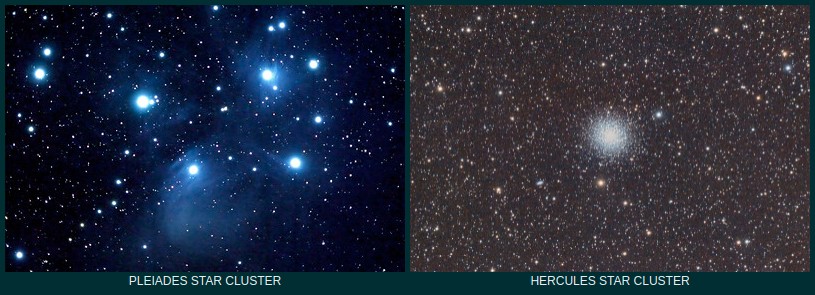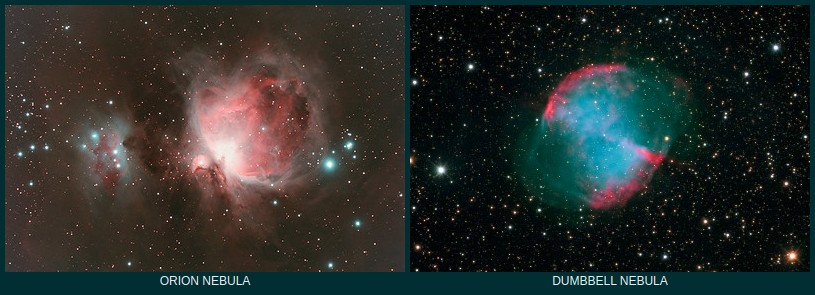7 Famous Deep Space Objects to Observe For Beginners
Here we describe several famous deep sky objects in the Northern Hemisphere which are bright, easy to find for beginners and visible even in binoculars or a small telescope. Observing deep sky objects is harder for a novice stargazer than observing nearby bright Solar system objects, however, it’s also extremely rewarding. To watch through your own telescope at a galaxy containing hundreds of billions of stars at a distance of several millions light years from the Earth is an unforgettable experience. The path to mastering in observational astronomy may become an exciting adventure for a curious stargazer.

Pleiades
Our first target is the famous Pleiades (M45 in the Messier Catalog). Also known as The Seven Sisters, it is an open star cluster in the constellation Taurus. Visually, it resembles a tiny dipper, and for this reason The Pleiades often is confused as the Little Dipper asterism. The cluster and its seven brightest stars in it are named after the Pleiades – nymphs from Greek mythology. It is one of the brightest star clusters and is visible to the naked eye even in the city night sky. Binoculars and telescopes show the cluster in all its glory, and you will be able to observe amazing star chains. The Pleiades are one of the nearest star clusters to Earth. The cluster contains about 3000 stars, however only 12 brightest ones of them are visible to the naked eye. They are hot blue stars which were formed within the last 100 million years. Astrophotography of the cluster will also reveal a blue nebula around the stars that is not visible with an amateur telescope.
Hercules Cluster
Another favorite target of amateur astronomers is The Hercules Cluster (M13) in the constellation of Hercules. It is one of the brightest clusters in the Galaxy, and sometimes it is called the Great Globular Cluster in Hercules. Under good observing conditions it may be visible to the naked eye. In binoculars or a small telescope or it looks like a blurred spot. To resolve stars in the cluster a telescope with an aperture of 100mm and a magnification of 100x or higher is required. The cluster is about 25,000 light-years away from us. M13 consists of several hundred thousand stars, and has a diameter of 150 light-years. The Hercules Cluster is very dense, and stars sometimes collide in it.
Albireo
To the naked eye, Albireo looks like a single star. However, if you aim even a small telescope or binoculars at it, you might say “wow”, because you will see two stars and they have different colors! Albireo is a double star in the constellation of Cygnus. And it is one of the most beautiful double stars that you can admire through an amature telescope. One big star is orange in color while the other is bright blue. Albireo is about 420 light-years from us and scientists still don’t know whether the two stars revolve around each other or they just appear close to us in the sky.

Andromeda Galaxy
The Andromeda Galaxy, catalogued as M31, is probably the most famous galaxy because it has the largest apparent size in the Northern night sky and is one of the best targets for binoculars and telescopes. Its apparent size is so enormous that it exceeds several times the diameter of the lunar disk.
It is the brightest galaxy in the Northern Hemisphere, however, Andromeda is still a very dim object because its light is distributed over a large area. In the night sky it is located in the constellation of Andromeda which is named after the wife of Perseus in Greek mythology. In a very dark sky, you can see the bright center of the Andromeda with the naked eye. Through binoculars and a small telescope, it is visible as an oval grayish spot. To show the entire object, your optical instrument must have a sufficiently small focal length.
Andromeda is a spiral galaxy, and its spiral arms are clearly seen in astrophotography pictures. It is located 2.5 million light-years away from Earth. It is believed that our Galaxy is very similar to Andromeda. The center of the galaxy contains a massive black hole surrounded by a dense and compact star cluster. The Andromeda Galaxy contains about one trillion stars, which is about twice as much as the number of stars in our Milky Way galaxy.
Triangulum Galaxy
The small Northern constellation Triangulum is home to a charming spiral galaxy facing us. The Triangulum Galaxy, also known as M33 or NGC 598, gets its name from the constellation in which it appears. Sometimes also called Pinwheel Galaxy by amateur astronomers, it is one of the most attractive objects to observe.
M33 is visible to the unaided eye in areas with no light pollution in the dark moonless night in the form of a dull misty speck. The Triangulum Galaxy is one of the most distant celestial objects, visible to the naked eye in good weather.
In order to view the structure of M33, a telescope with an aperture of 200mm or more and an eyepiece with a wide field of view should be used. The galaxy looks like a slightly oval diffuse spot with a slight increase in brightness towards the center. Sometimes the outer spiral arms can also be seen.
The Triangulum Galaxy is 3 million light years away from us. The diameter of M33 is more than 60,000 light-years which is an average size of a typical spiral galaxy, and it is two times smaller than the Milky Way. It is believed that M33 is a satellite of the Andromeda Galaxy.

Orion Nebula
One of the brightest deep sky objects, M42 in the constellation Orion can be seen with the naked eye even in city night sky affected by light pollution, and the telescope will show a complex gas and dust structure, similar to clouds of smoke. The Orion Nebula is a great and amazing object to observe and one of the most photographed and studied deep sky objects. Also, it is one of the largest objects in the night sky as its apparent size is about twice the apparent size of the Moon. Previously called the Great Orion Nebula, it is a diffuse nebula which resides 1,344 light-years away and has a diameter of about 23 light-years. There are four bright stars in the center of the nebula which are part of a tiny open star cluster called Trapezium Cluster.
Dumbbell Nebula
The Dumbbell Nebula, which is cataloged as M27 or NGC 6853, is probably the most impressive planetary nebula in the sky. It is one of the brightest planetary nebulae and can be seen in binoculars or a small telescope. In the star charts M27 resides in the constellation of Vulpecula, and it is 1200 light years away from us. The planetary nebula is an ionized, glowing gas dropped by an old red giant star. Estimated age of the Dumbbell Nebula is about 4,000 years. On astronomical time scales, planetary nebulae are short-lived phenomena and have an age of several tens of thousands of years. It is believed that our Sun at the final stage of its evolution will become a red giant, and then will drop its shell, which will become a planetary nebula.
